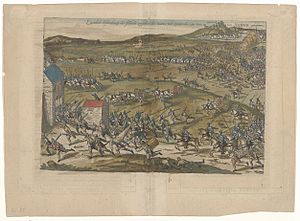Battle of Gembloux
| Battle of Gembloux | |||||||
|---|---|---|---|---|---|---|---|
| Part of the Eighty Years' War and the Anglo-Spanish War (1585–1604) | |||||||
 Engraving of the Battle of Gembloux by Frans Hogenberg. |
|||||||
|
|||||||
| Belligerents | |||||||
|
|
|
||||||
| Commanders and leaders | |||||||
|
Martin Schenck Emanuel Philibert de Lalaing Count of Egmont Marquis d’Havré |
|
||||||
| Strength | |||||||
| 25,000 men | 17,000–20,000 (Only engaged 1,200 cavalry in the first phase of the battle) |
||||||
| Casualties and losses | |||||||
| 8,000–11,000 dead (6,000 killed in the cavalry charge led by Parma) Hundreds of prisoners |
20 dead or wounded (12 dead in action) |
||||||
The Battle of Gembloux took place at Gembloux, near Namur, Low Countries, between the Spanish forces led by Don John of Austria (Spanish: Don Juan de Austria),Governor-General of the Spanish Netherlands, and a rebel army composed of Dutch, Flemish, English, Scottish, German, French and Walloon soldiers under Antoine de Goignies, during the Eighty Years' War and the Anglo-Spanish War (1585–1604). On January 31, 1578, the Spanish cavalry commanded by John's nephew, Don Alexander Farnese, Prince of Parma (Italian: Alessandro Farnese, Spanish: Alejandro Farnesio), after pushing back the Dutch cavalry, attacked the Netherlandish army, causing an enormous panic amongst the rebel troops. The result was a crushing victory for the Spanish forces. The battle hastened the disintegration of the unity of the rebel provinces, and meant the end of the Union of Brussels.
After the Sack of Antwerp by Spanish mutineers on November 4, 1576, Catholics and Protestants of the Low Countries concluded the Pacification of Ghent, to remove all Spanish troops. The Spanish tercios were in fact withdrawn to Italy in April 1577, after the new Governor-General of the Spanish Netherlands, the famous Christian knight, and half-brother of Philip II of Spain, Don John of Austria (victor of Lepanto), had signed the Perpetual Edict.
...
Wikipedia
